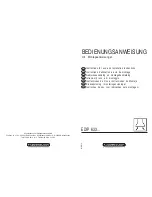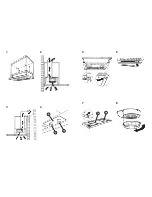
INSTALLATION
--------------------------------------------------
The equipment can be used for external evacu-
ation, suction, or for internal recycling of air,
filtering.
When the
filtering
version is in use, the air
and fumes cleaned by the active charcoalfilter
are recirculated in the room (Fig. 2).
When the
suction
version is in use the fumes
are conveyed upwards through a flue pipe and
evacuated directly towards the outside (Fig. 3).
The charcoalfilters are no more necessary.
Fixing to cupboard
: hook apparatus to bottom
of cupboard using the four screws supplied
(Fig. 1).
OPERATION
--------------------------------------------------
Motor and light can be operated automatically
by opening or closing the visor (Fig. 4).
Independently of this, rotary knob A sets working
speed of motor.
Knob B selects automatic or manual operation
of the light.
C = Operation pilot lamp.
To remove the grease screen (Fig. 7-C),
open
the grille
. To do it open the front visor, slide the
two side stays towards the center (Fig. 5-A) and
rotate the grille downwards. Detach filter from
grille by removing wire stays (Fig. 7-B).
If necessary, the grille can be removed by
disconnecting the flexible spring A (Fig. 7).
If the filtering version of the equipment is used,
the
active charcoalfilter
should be changed
every 6 months on average.
To gain access to the charcoalfilter open the
visor and remove the grille; to free the filter ro-
tate it untill completely released. Replace the
filter by reverse rotation (Fig. 8).
For a more through and easy cleaning, the
telescopic visor can easily be removed by raising
the two runners stops (Fig. 5-B) and
disconnecting the visor from its support.
When replacing the visor, make sure the
runners are perfectly fit in their seats.
To change the bulb
, unhook the grille, open
the visor, remove the bowl by pressing it from
the inside (Fig. 6) and take the bulb out.
Use bulbs of the same type.
WARNING
---------------------------------------------------
The distance between the hob and the lower
part of the hood must be at least 65 cm.
The air collected must not be conveyed into
a duct used to blow off smokes from ap-
pliances fed with an energy other than
electricity (central heating systems, ther-
mosiphons, water-heaters, etc.).
Comply with the official instructions provided
by the competent authorities in merit when
installing the disposal duct.
The room must be well aerated in case a
hood and some other heat equipment fed
with an energy other than electricity (gas,
oil, coal heaters, etc) operate at the same
time.
In fact the intake hood, disposing of air,
could create a vacuum in the room. The
vacuum should not exceed 0,04mbar. This
prevents the gas exhausted by the heat
source from being intaken again. It is
therefore advisable to ensure the room
contains air taps able to ensure a steady
flow of fresh air.
ATTENTION: This appliance must be
grounded.
The following warning is valid in the United
Kingdom only:
As the colours of the wires in the mains
lead of this appliance may not correspond
with the coloured markings identifying the
terminals in your plug, proceed as follows:
– the wire which is coloured green and
yellow must be connected to the terminal
in the plug which is marked with the letter
E or by the earth symbol [ ], or co-
loured green or green and yellow;
– the wire which is coloured blue must be
connected to the terminal which is marked
with the letter N or coloured black;
– the wire which is coloured brown must
be connected to the terminal which is
marked with the letter L or coloured red.
When making the electrical connections,
check that the current socket has a ground
English
connection and that the voltage values
correspond to those indicated on the data
plate inside the appliance itself.
In case your appliance is not furnished with
a non separating flexible cable and has no
plug, or has not got any other device ensu-
ring omnipolar disconnection from the elec-
tricity main, with a contact opening distance
of at least 3 mm, such separating device
ensuring disconnection from the main must
be included in the fixed installation.
Always switch off the electricity supply be-
fore carrying out any cleaning or servicing
operations on the appliance.
USE
---------------------------------------------------
Avoid using materials which could cause
spurts of flame (flambées) near the ap-
pliance.
When frying, take particular care to prevent
oil and grease from catching fire. Already
used oil is especially dangerous in this re-
spect. Do not use uncovered electric grates.
To avoid possible risks of fire always comply
with the indicated instructions when cleaning
anti-grease filters and when removing
grease deposits from the appliance.
MAINTENANCE
---------------------------------------------------
Thorough servicing guarantees correct and
long-lasting operation.
Particular care must be paid to the grease
filtering panels which must be periodically
cleaned in relation to use (at least once
every two months). Remove the grease
filters and wash them either by hand or in
the dishwasher using neutral detergent (60°).
Use lukewarm water and neutral detergent
to clean painted appliances. Never use
products containing abrasives.
Take great care to prevent the use of cor-
rosive or abrasive products when cleaning
steel, copper or brass appliances. It is advi-
sable to use specialized products according
to the manufacturer’s instructions.





















